Off-shoring Project Management: Risks, Quality, and Strategies
VerifiedAdded on 2021/05/31
|11
|2436
|37
Report
AI Summary
This report examines the multifaceted aspects of off-shoring projects, focusing on the identification of risks and evaluation of quality issues across the project life cycle, which includes conceptualization, design, implementation, finalization, and control. The report delves into potential pitfalls at each stage, such as misalignment with company strategy, inappropriate business decisions, communication breakdowns, and poor resource management. Furthermore, it assesses quality issues like inadequate project implementation, failure to identify risks, and lack of stakeholder involvement. To address these challenges, the report proposes several strategies, including implementing comprehensive training programs for managers, improving communication channels, and adopting innovative resource management approaches. The study emphasizes the importance of careful analysis, sound projections, and a proactive approach to ensure successful off-shoring outcomes.

Running head: OFF-SHORING
Off-shoring
Name of Student
Name of University
Author Note
Off-shoring
Name of Student
Name of University
Author Note
Paraphrase This Document
Need a fresh take? Get an instant paraphrase of this document with our AI Paraphraser
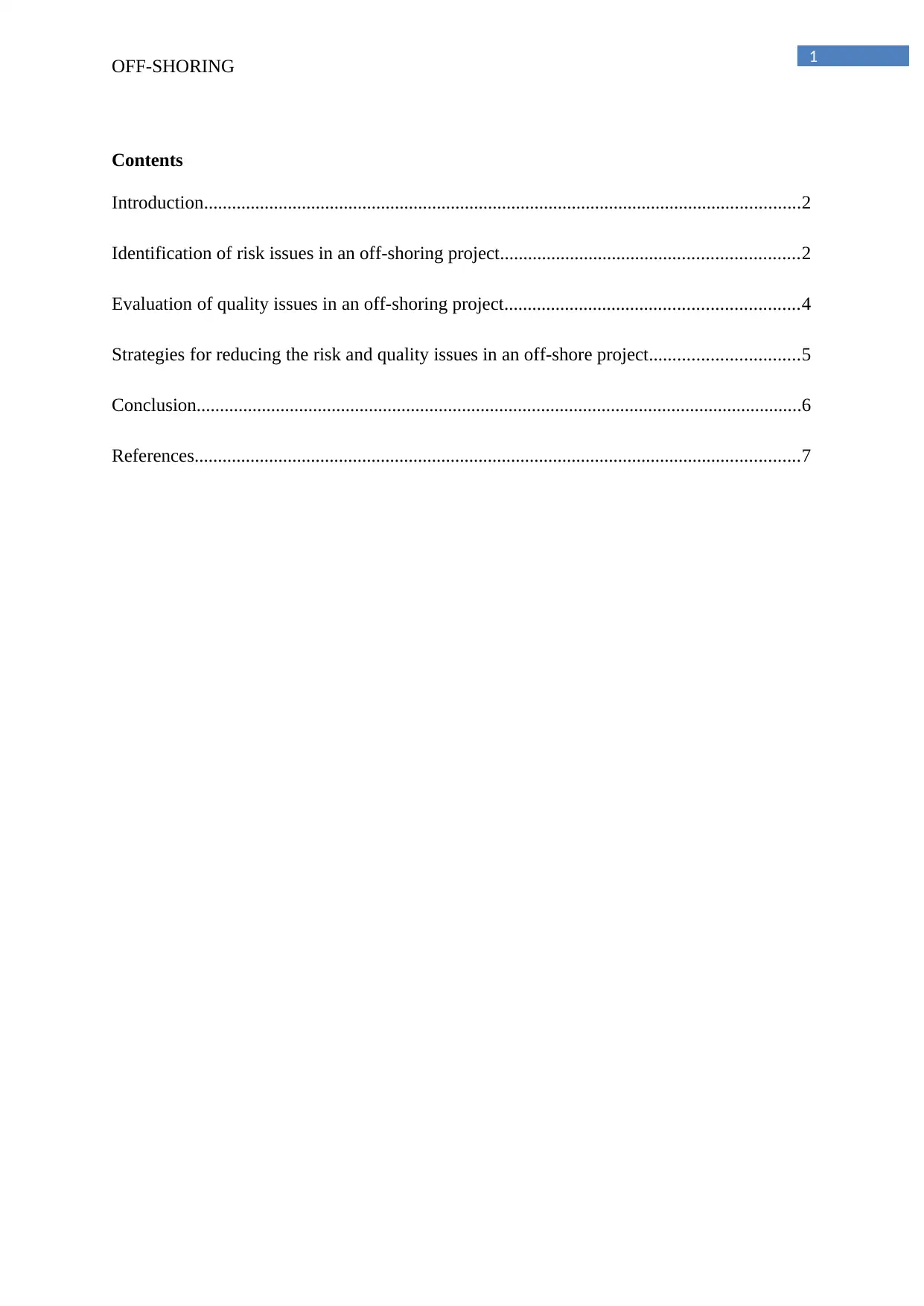
1
OFF-SHORING
Contents
Introduction................................................................................................................................2
Identification of risk issues in an off-shoring project................................................................2
Evaluation of quality issues in an off-shoring project...............................................................4
Strategies for reducing the risk and quality issues in an off-shore project................................5
Conclusion..................................................................................................................................6
References..................................................................................................................................7
OFF-SHORING
Contents
Introduction................................................................................................................................2
Identification of risk issues in an off-shoring project................................................................2
Evaluation of quality issues in an off-shoring project...............................................................4
Strategies for reducing the risk and quality issues in an off-shore project................................5
Conclusion..................................................................................................................................6
References..................................................................................................................................7
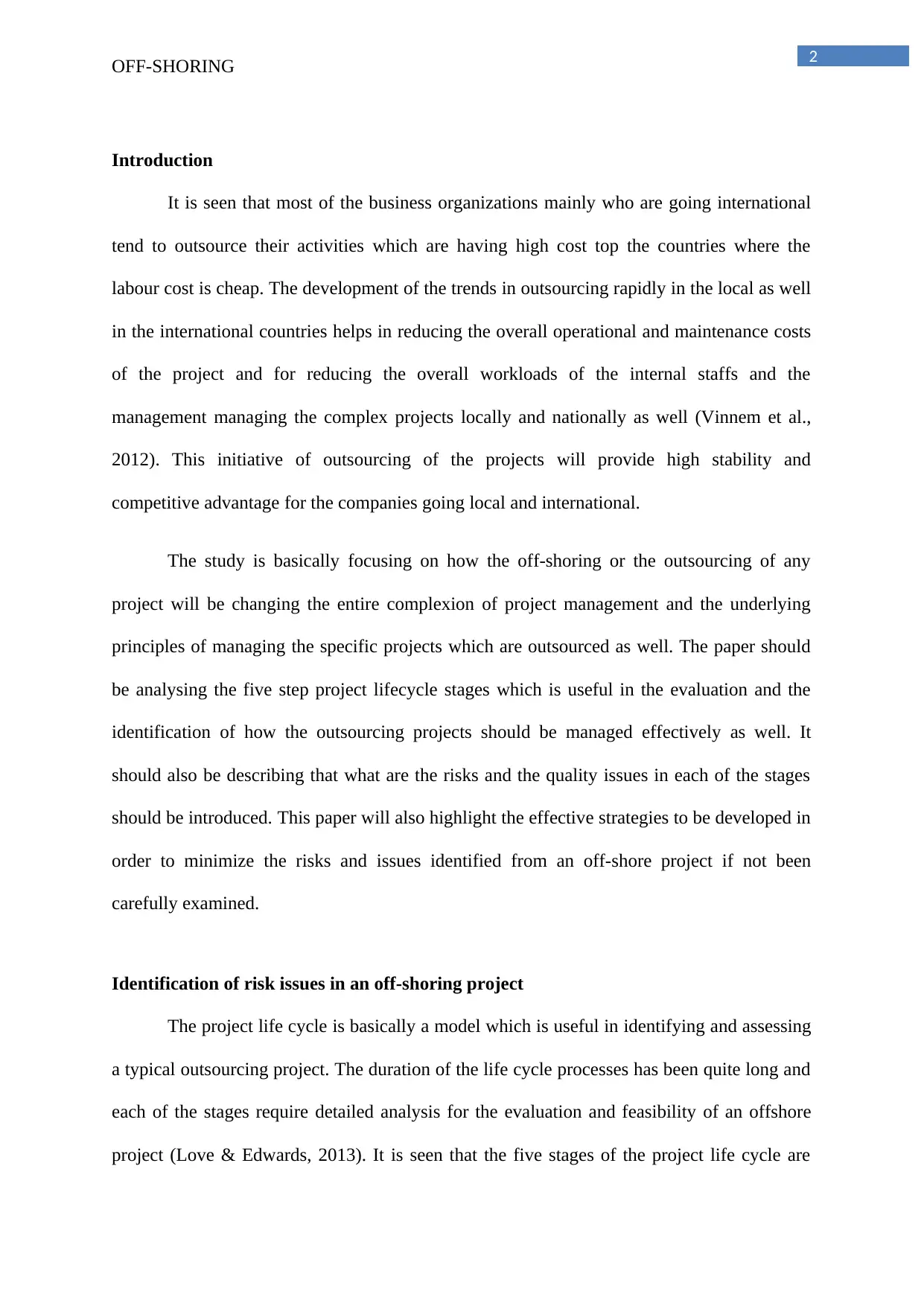
2
OFF-SHORING
Introduction
It is seen that most of the business organizations mainly who are going international
tend to outsource their activities which are having high cost top the countries where the
labour cost is cheap. The development of the trends in outsourcing rapidly in the local as well
in the international countries helps in reducing the overall operational and maintenance costs
of the project and for reducing the overall workloads of the internal staffs and the
management managing the complex projects locally and nationally as well (Vinnem et al.,
2012). This initiative of outsourcing of the projects will provide high stability and
competitive advantage for the companies going local and international.
The study is basically focusing on how the off-shoring or the outsourcing of any
project will be changing the entire complexion of project management and the underlying
principles of managing the specific projects which are outsourced as well. The paper should
be analysing the five step project lifecycle stages which is useful in the evaluation and the
identification of how the outsourcing projects should be managed effectively as well. It
should also be describing that what are the risks and the quality issues in each of the stages
should be introduced. This paper will also highlight the effective strategies to be developed in
order to minimize the risks and issues identified from an off-shore project if not been
carefully examined.
Identification of risk issues in an off-shoring project
The project life cycle is basically a model which is useful in identifying and assessing
a typical outsourcing project. The duration of the life cycle processes has been quite long and
each of the stages require detailed analysis for the evaluation and feasibility of an offshore
project (Love & Edwards, 2013). It is seen that the five stages of the project life cycle are
OFF-SHORING
Introduction
It is seen that most of the business organizations mainly who are going international
tend to outsource their activities which are having high cost top the countries where the
labour cost is cheap. The development of the trends in outsourcing rapidly in the local as well
in the international countries helps in reducing the overall operational and maintenance costs
of the project and for reducing the overall workloads of the internal staffs and the
management managing the complex projects locally and nationally as well (Vinnem et al.,
2012). This initiative of outsourcing of the projects will provide high stability and
competitive advantage for the companies going local and international.
The study is basically focusing on how the off-shoring or the outsourcing of any
project will be changing the entire complexion of project management and the underlying
principles of managing the specific projects which are outsourced as well. The paper should
be analysing the five step project lifecycle stages which is useful in the evaluation and the
identification of how the outsourcing projects should be managed effectively as well. It
should also be describing that what are the risks and the quality issues in each of the stages
should be introduced. This paper will also highlight the effective strategies to be developed in
order to minimize the risks and issues identified from an off-shore project if not been
carefully examined.
Identification of risk issues in an off-shoring project
The project life cycle is basically a model which is useful in identifying and assessing
a typical outsourcing project. The duration of the life cycle processes has been quite long and
each of the stages require detailed analysis for the evaluation and feasibility of an offshore
project (Love & Edwards, 2013). It is seen that the five stages of the project life cycle are
⊘ This is a preview!⊘
Do you want full access?
Subscribe today to unlock all pages.

Trusted by 1+ million students worldwide
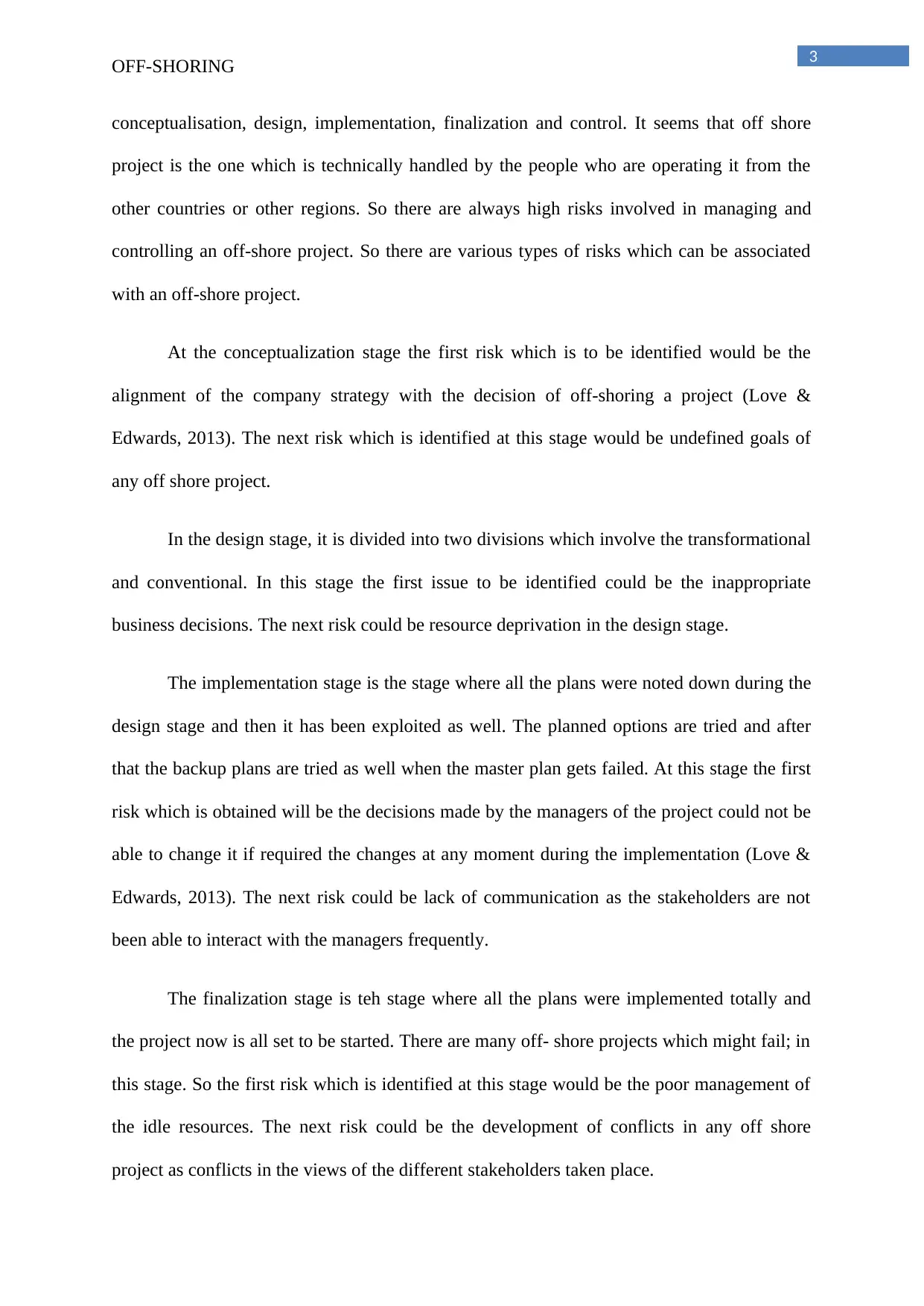
3
OFF-SHORING
conceptualisation, design, implementation, finalization and control. It seems that off shore
project is the one which is technically handled by the people who are operating it from the
other countries or other regions. So there are always high risks involved in managing and
controlling an off-shore project. So there are various types of risks which can be associated
with an off-shore project.
At the conceptualization stage the first risk which is to be identified would be the
alignment of the company strategy with the decision of off-shoring a project (Love &
Edwards, 2013). The next risk which is identified at this stage would be undefined goals of
any off shore project.
In the design stage, it is divided into two divisions which involve the transformational
and conventional. In this stage the first issue to be identified could be the inappropriate
business decisions. The next risk could be resource deprivation in the design stage.
The implementation stage is the stage where all the plans were noted down during the
design stage and then it has been exploited as well. The planned options are tried and after
that the backup plans are tried as well when the master plan gets failed. At this stage the first
risk which is obtained will be the decisions made by the managers of the project could not be
able to change it if required the changes at any moment during the implementation (Love &
Edwards, 2013). The next risk could be lack of communication as the stakeholders are not
been able to interact with the managers frequently.
The finalization stage is teh stage where all the plans were implemented totally and
the project now is all set to be started. There are many off- shore projects which might fail; in
this stage. So the first risk which is identified at this stage would be the poor management of
the idle resources. The next risk could be the development of conflicts in any off shore
project as conflicts in the views of the different stakeholders taken place.
OFF-SHORING
conceptualisation, design, implementation, finalization and control. It seems that off shore
project is the one which is technically handled by the people who are operating it from the
other countries or other regions. So there are always high risks involved in managing and
controlling an off-shore project. So there are various types of risks which can be associated
with an off-shore project.
At the conceptualization stage the first risk which is to be identified would be the
alignment of the company strategy with the decision of off-shoring a project (Love &
Edwards, 2013). The next risk which is identified at this stage would be undefined goals of
any off shore project.
In the design stage, it is divided into two divisions which involve the transformational
and conventional. In this stage the first issue to be identified could be the inappropriate
business decisions. The next risk could be resource deprivation in the design stage.
The implementation stage is the stage where all the plans were noted down during the
design stage and then it has been exploited as well. The planned options are tried and after
that the backup plans are tried as well when the master plan gets failed. At this stage the first
risk which is obtained will be the decisions made by the managers of the project could not be
able to change it if required the changes at any moment during the implementation (Love &
Edwards, 2013). The next risk could be lack of communication as the stakeholders are not
been able to interact with the managers frequently.
The finalization stage is teh stage where all the plans were implemented totally and
the project now is all set to be started. There are many off- shore projects which might fail; in
this stage. So the first risk which is identified at this stage would be the poor management of
the idle resources. The next risk could be the development of conflicts in any off shore
project as conflicts in the views of the different stakeholders taken place.
Paraphrase This Document
Need a fresh take? Get an instant paraphrase of this document with our AI Paraphraser
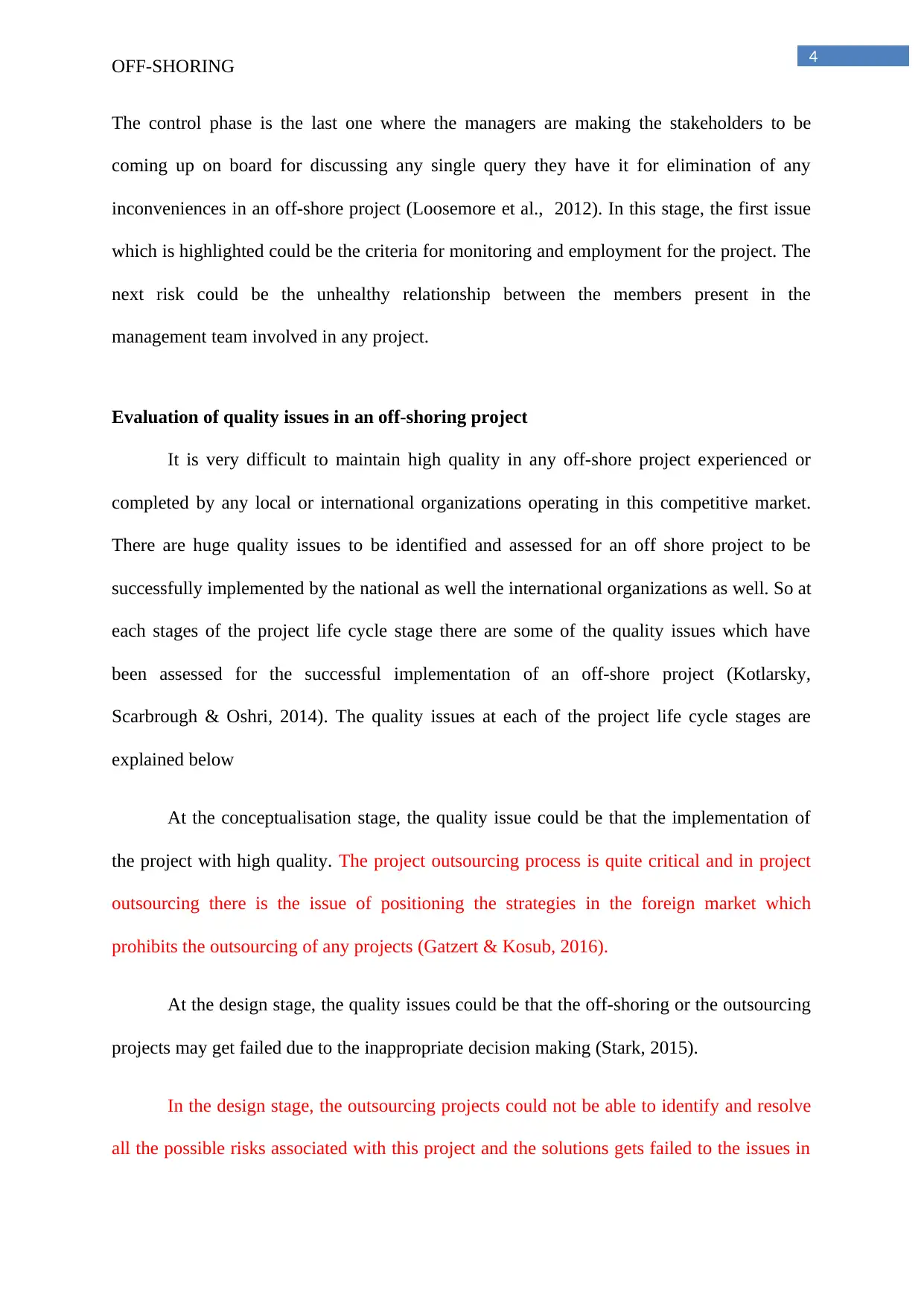
4
OFF-SHORING
The control phase is the last one where the managers are making the stakeholders to be
coming up on board for discussing any single query they have it for elimination of any
inconveniences in an off-shore project (Loosemore et al., 2012). In this stage, the first issue
which is highlighted could be the criteria for monitoring and employment for the project. The
next risk could be the unhealthy relationship between the members present in the
management team involved in any project.
Evaluation of quality issues in an off-shoring project
It is very difficult to maintain high quality in any off-shore project experienced or
completed by any local or international organizations operating in this competitive market.
There are huge quality issues to be identified and assessed for an off shore project to be
successfully implemented by the national as well the international organizations as well. So at
each stages of the project life cycle stage there are some of the quality issues which have
been assessed for the successful implementation of an off-shore project (Kotlarsky,
Scarbrough & Oshri, 2014). The quality issues at each of the project life cycle stages are
explained below
At the conceptualisation stage, the quality issue could be that the implementation of
the project with high quality. The project outsourcing process is quite critical and in project
outsourcing there is the issue of positioning the strategies in the foreign market which
prohibits the outsourcing of any projects (Gatzert & Kosub, 2016).
At the design stage, the quality issues could be that the off-shoring or the outsourcing
projects may get failed due to the inappropriate decision making (Stark, 2015).
In the design stage, the outsourcing projects could not be able to identify and resolve
all the possible risks associated with this project and the solutions gets failed to the issues in
OFF-SHORING
The control phase is the last one where the managers are making the stakeholders to be
coming up on board for discussing any single query they have it for elimination of any
inconveniences in an off-shore project (Loosemore et al., 2012). In this stage, the first issue
which is highlighted could be the criteria for monitoring and employment for the project. The
next risk could be the unhealthy relationship between the members present in the
management team involved in any project.
Evaluation of quality issues in an off-shoring project
It is very difficult to maintain high quality in any off-shore project experienced or
completed by any local or international organizations operating in this competitive market.
There are huge quality issues to be identified and assessed for an off shore project to be
successfully implemented by the national as well the international organizations as well. So at
each stages of the project life cycle stage there are some of the quality issues which have
been assessed for the successful implementation of an off-shore project (Kotlarsky,
Scarbrough & Oshri, 2014). The quality issues at each of the project life cycle stages are
explained below
At the conceptualisation stage, the quality issue could be that the implementation of
the project with high quality. The project outsourcing process is quite critical and in project
outsourcing there is the issue of positioning the strategies in the foreign market which
prohibits the outsourcing of any projects (Gatzert & Kosub, 2016).
At the design stage, the quality issues could be that the off-shoring or the outsourcing
projects may get failed due to the inappropriate decision making (Stark, 2015).
In the design stage, the outsourcing projects could not be able to identify and resolve
all the possible risks associated with this project and the solutions gets failed to the issues in
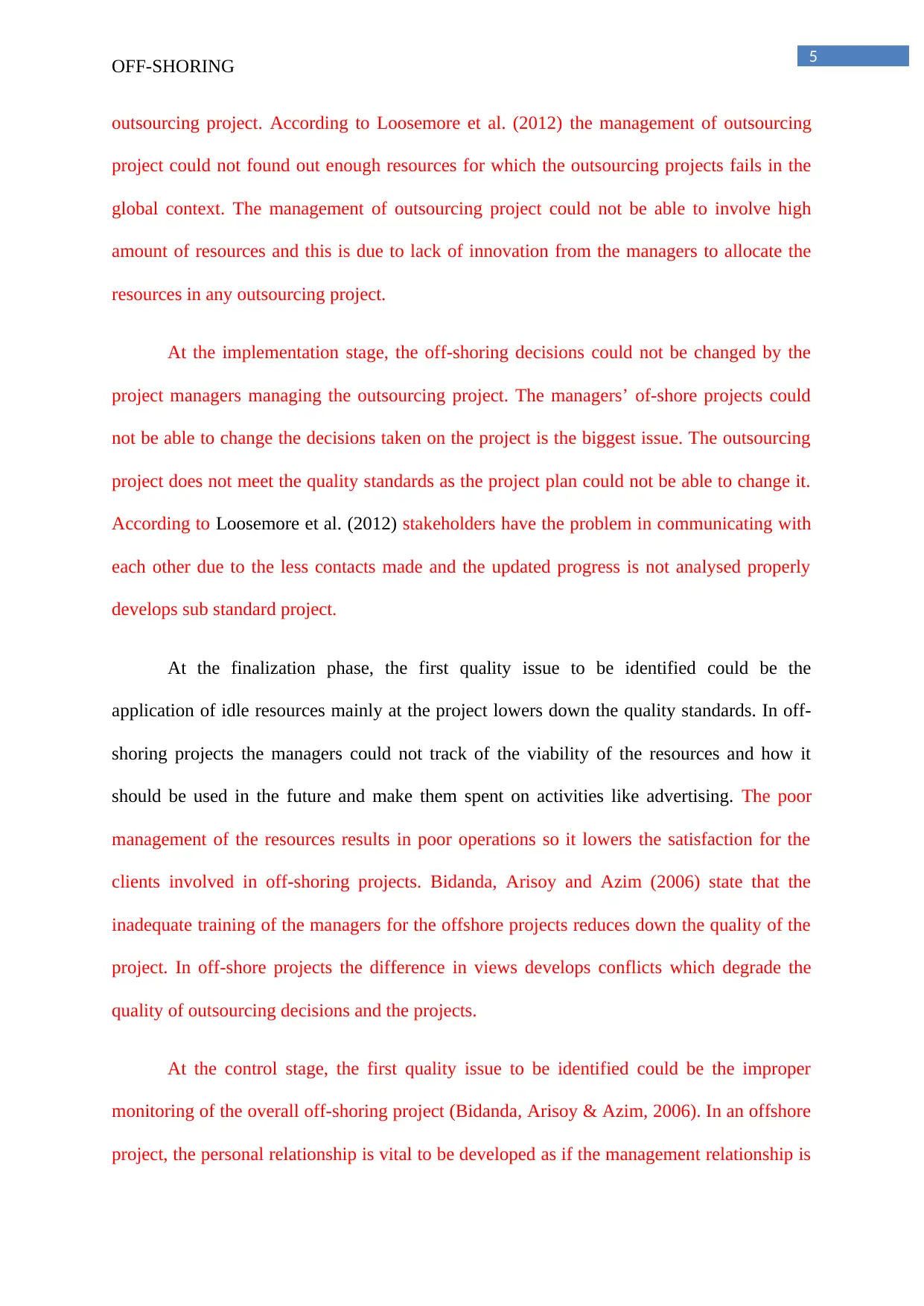
5
OFF-SHORING
outsourcing project. According to Loosemore et al. (2012) the management of outsourcing
project could not found out enough resources for which the outsourcing projects fails in the
global context. The management of outsourcing project could not be able to involve high
amount of resources and this is due to lack of innovation from the managers to allocate the
resources in any outsourcing project.
At the implementation stage, the off-shoring decisions could not be changed by the
project managers managing the outsourcing project. The managers’ of-shore projects could
not be able to change the decisions taken on the project is the biggest issue. The outsourcing
project does not meet the quality standards as the project plan could not be able to change it.
According to Loosemore et al. (2012) stakeholders have the problem in communicating with
each other due to the less contacts made and the updated progress is not analysed properly
develops sub standard project.
At the finalization phase, the first quality issue to be identified could be the
application of idle resources mainly at the project lowers down the quality standards. In off-
shoring projects the managers could not track of the viability of the resources and how it
should be used in the future and make them spent on activities like advertising. The poor
management of the resources results in poor operations so it lowers the satisfaction for the
clients involved in off-shoring projects. Bidanda, Arisoy and Azim (2006) state that the
inadequate training of the managers for the offshore projects reduces down the quality of the
project. In off-shore projects the difference in views develops conflicts which degrade the
quality of outsourcing decisions and the projects.
At the control stage, the first quality issue to be identified could be the improper
monitoring of the overall off-shoring project (Bidanda, Arisoy & Azim, 2006). In an offshore
project, the personal relationship is vital to be developed as if the management relationship is
OFF-SHORING
outsourcing project. According to Loosemore et al. (2012) the management of outsourcing
project could not found out enough resources for which the outsourcing projects fails in the
global context. The management of outsourcing project could not be able to involve high
amount of resources and this is due to lack of innovation from the managers to allocate the
resources in any outsourcing project.
At the implementation stage, the off-shoring decisions could not be changed by the
project managers managing the outsourcing project. The managers’ of-shore projects could
not be able to change the decisions taken on the project is the biggest issue. The outsourcing
project does not meet the quality standards as the project plan could not be able to change it.
According to Loosemore et al. (2012) stakeholders have the problem in communicating with
each other due to the less contacts made and the updated progress is not analysed properly
develops sub standard project.
At the finalization phase, the first quality issue to be identified could be the
application of idle resources mainly at the project lowers down the quality standards. In off-
shoring projects the managers could not track of the viability of the resources and how it
should be used in the future and make them spent on activities like advertising. The poor
management of the resources results in poor operations so it lowers the satisfaction for the
clients involved in off-shoring projects. Bidanda, Arisoy and Azim (2006) state that the
inadequate training of the managers for the offshore projects reduces down the quality of the
project. In off-shore projects the difference in views develops conflicts which degrade the
quality of outsourcing decisions and the projects.
At the control stage, the first quality issue to be identified could be the improper
monitoring of the overall off-shoring project (Bidanda, Arisoy & Azim, 2006). In an offshore
project, the personal relationship is vital to be developed as if the management relationship is
⊘ This is a preview!⊘
Do you want full access?
Subscribe today to unlock all pages.

Trusted by 1+ million students worldwide
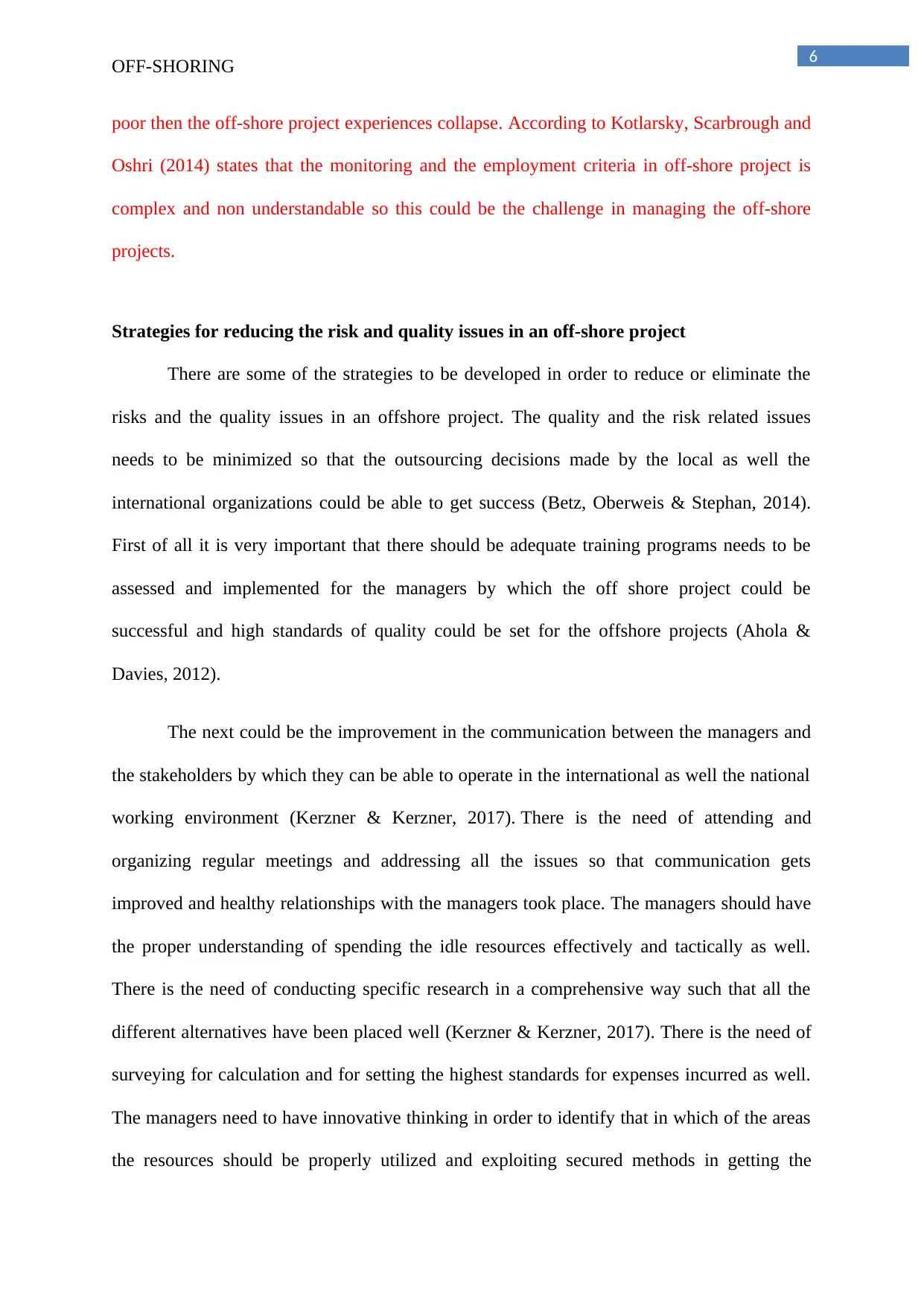
6
OFF-SHORING
poor then the off-shore project experiences collapse. According to Kotlarsky, Scarbrough and
Oshri (2014) states that the monitoring and the employment criteria in off-shore project is
complex and non understandable so this could be the challenge in managing the off-shore
projects.
Strategies for reducing the risk and quality issues in an off-shore project
There are some of the strategies to be developed in order to reduce or eliminate the
risks and the quality issues in an offshore project. The quality and the risk related issues
needs to be minimized so that the outsourcing decisions made by the local as well the
international organizations could be able to get success (Betz, Oberweis & Stephan, 2014).
First of all it is very important that there should be adequate training programs needs to be
assessed and implemented for the managers by which the off shore project could be
successful and high standards of quality could be set for the offshore projects (Ahola &
Davies, 2012).
The next could be the improvement in the communication between the managers and
the stakeholders by which they can be able to operate in the international as well the national
working environment (Kerzner & Kerzner, 2017). There is the need of attending and
organizing regular meetings and addressing all the issues so that communication gets
improved and healthy relationships with the managers took place. The managers should have
the proper understanding of spending the idle resources effectively and tactically as well.
There is the need of conducting specific research in a comprehensive way such that all the
different alternatives have been placed well (Kerzner & Kerzner, 2017). There is the need of
surveying for calculation and for setting the highest standards for expenses incurred as well.
The managers need to have innovative thinking in order to identify that in which of the areas
the resources should be properly utilized and exploiting secured methods in getting the
OFF-SHORING
poor then the off-shore project experiences collapse. According to Kotlarsky, Scarbrough and
Oshri (2014) states that the monitoring and the employment criteria in off-shore project is
complex and non understandable so this could be the challenge in managing the off-shore
projects.
Strategies for reducing the risk and quality issues in an off-shore project
There are some of the strategies to be developed in order to reduce or eliminate the
risks and the quality issues in an offshore project. The quality and the risk related issues
needs to be minimized so that the outsourcing decisions made by the local as well the
international organizations could be able to get success (Betz, Oberweis & Stephan, 2014).
First of all it is very important that there should be adequate training programs needs to be
assessed and implemented for the managers by which the off shore project could be
successful and high standards of quality could be set for the offshore projects (Ahola &
Davies, 2012).
The next could be the improvement in the communication between the managers and
the stakeholders by which they can be able to operate in the international as well the national
working environment (Kerzner & Kerzner, 2017). There is the need of attending and
organizing regular meetings and addressing all the issues so that communication gets
improved and healthy relationships with the managers took place. The managers should have
the proper understanding of spending the idle resources effectively and tactically as well.
There is the need of conducting specific research in a comprehensive way such that all the
different alternatives have been placed well (Kerzner & Kerzner, 2017). There is the need of
surveying for calculation and for setting the highest standards for expenses incurred as well.
The managers need to have innovative thinking in order to identify that in which of the areas
the resources should be properly utilized and exploiting secured methods in getting the
Paraphrase This Document
Need a fresh take? Get an instant paraphrase of this document with our AI Paraphraser
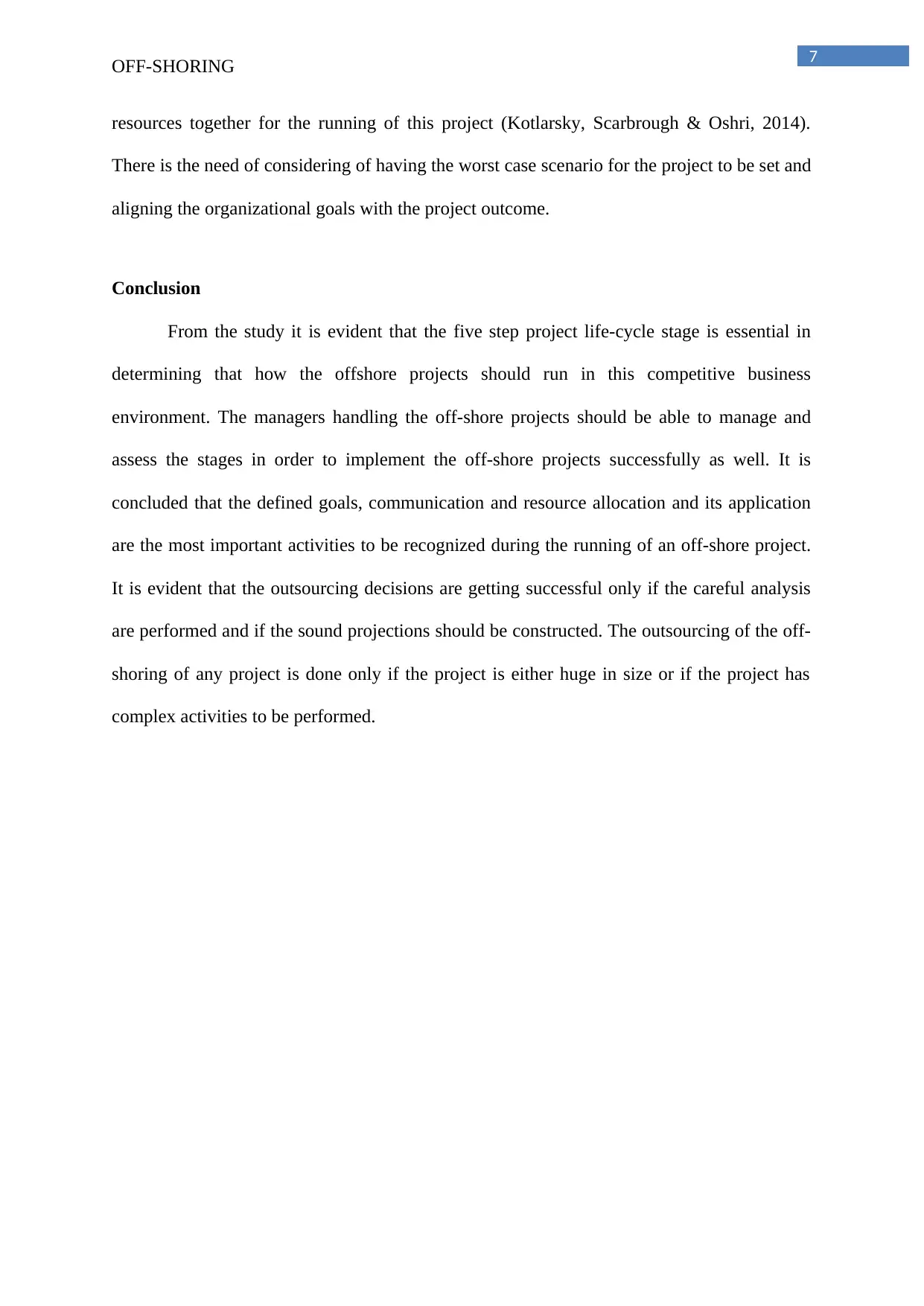
7
OFF-SHORING
resources together for the running of this project (Kotlarsky, Scarbrough & Oshri, 2014).
There is the need of considering of having the worst case scenario for the project to be set and
aligning the organizational goals with the project outcome.
Conclusion
From the study it is evident that the five step project life-cycle stage is essential in
determining that how the offshore projects should run in this competitive business
environment. The managers handling the off-shore projects should be able to manage and
assess the stages in order to implement the off-shore projects successfully as well. It is
concluded that the defined goals, communication and resource allocation and its application
are the most important activities to be recognized during the running of an off-shore project.
It is evident that the outsourcing decisions are getting successful only if the careful analysis
are performed and if the sound projections should be constructed. The outsourcing of the off-
shoring of any project is done only if the project is either huge in size or if the project has
complex activities to be performed.
OFF-SHORING
resources together for the running of this project (Kotlarsky, Scarbrough & Oshri, 2014).
There is the need of considering of having the worst case scenario for the project to be set and
aligning the organizational goals with the project outcome.
Conclusion
From the study it is evident that the five step project life-cycle stage is essential in
determining that how the offshore projects should run in this competitive business
environment. The managers handling the off-shore projects should be able to manage and
assess the stages in order to implement the off-shore projects successfully as well. It is
concluded that the defined goals, communication and resource allocation and its application
are the most important activities to be recognized during the running of an off-shore project.
It is evident that the outsourcing decisions are getting successful only if the careful analysis
are performed and if the sound projections should be constructed. The outsourcing of the off-
shoring of any project is done only if the project is either huge in size or if the project has
complex activities to be performed.
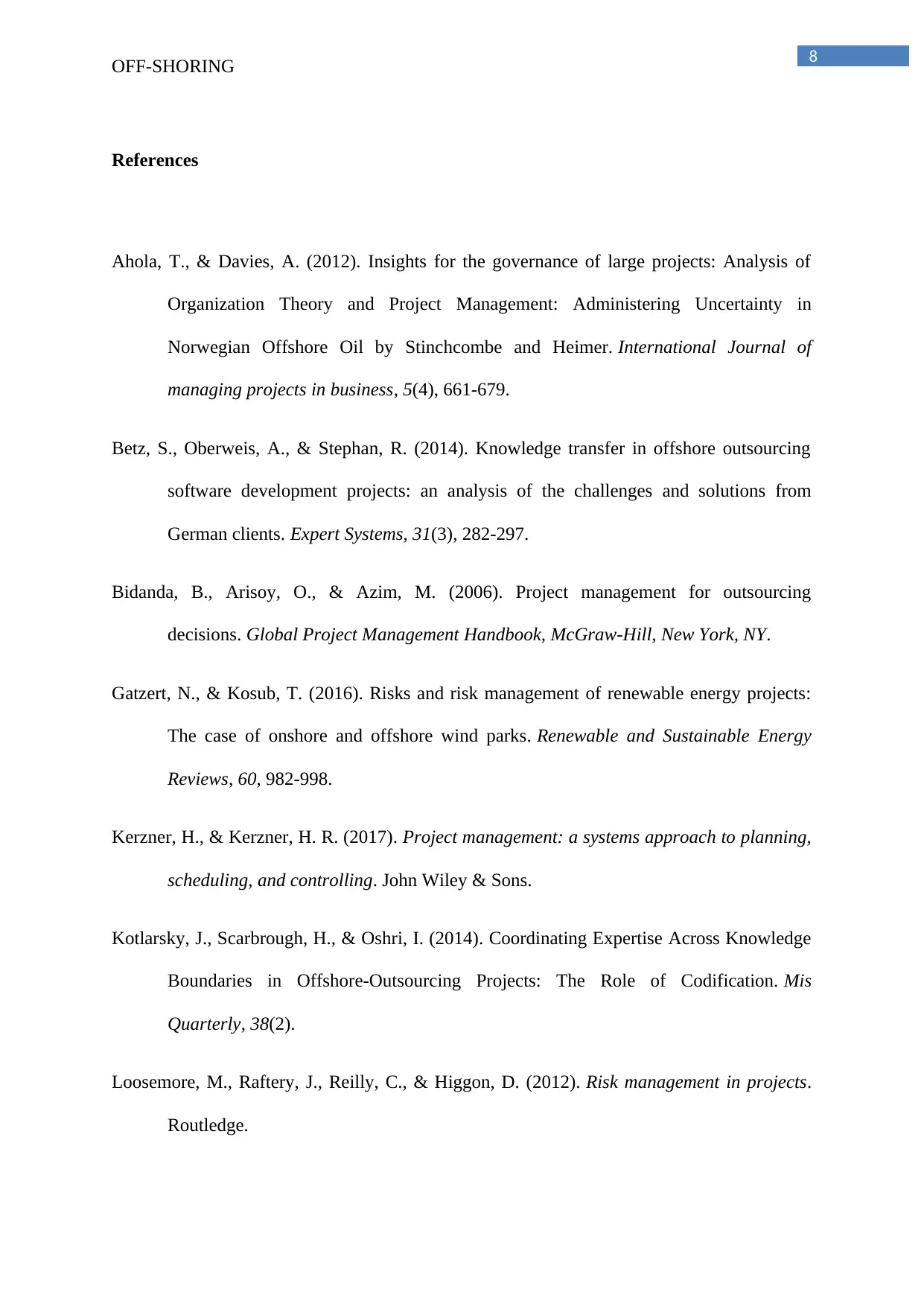
8
OFF-SHORING
References
Ahola, T., & Davies, A. (2012). Insights for the governance of large projects: Analysis of
Organization Theory and Project Management: Administering Uncertainty in
Norwegian Offshore Oil by Stinchcombe and Heimer. International Journal of
managing projects in business, 5(4), 661-679.
Betz, S., Oberweis, A., & Stephan, R. (2014). Knowledge transfer in offshore outsourcing
software development projects: an analysis of the challenges and solutions from
German clients. Expert Systems, 31(3), 282-297.
Bidanda, B., Arisoy, O., & Azim, M. (2006). Project management for outsourcing
decisions. Global Project Management Handbook, McGraw-Hill, New York, NY.
Gatzert, N., & Kosub, T. (2016). Risks and risk management of renewable energy projects:
The case of onshore and offshore wind parks. Renewable and Sustainable Energy
Reviews, 60, 982-998.
Kerzner, H., & Kerzner, H. R. (2017). Project management: a systems approach to planning,
scheduling, and controlling. John Wiley & Sons.
Kotlarsky, J., Scarbrough, H., & Oshri, I. (2014). Coordinating Expertise Across Knowledge
Boundaries in Offshore-Outsourcing Projects: The Role of Codification. Mis
Quarterly, 38(2).
Loosemore, M., Raftery, J., Reilly, C., & Higgon, D. (2012). Risk management in projects.
Routledge.
OFF-SHORING
References
Ahola, T., & Davies, A. (2012). Insights for the governance of large projects: Analysis of
Organization Theory and Project Management: Administering Uncertainty in
Norwegian Offshore Oil by Stinchcombe and Heimer. International Journal of
managing projects in business, 5(4), 661-679.
Betz, S., Oberweis, A., & Stephan, R. (2014). Knowledge transfer in offshore outsourcing
software development projects: an analysis of the challenges and solutions from
German clients. Expert Systems, 31(3), 282-297.
Bidanda, B., Arisoy, O., & Azim, M. (2006). Project management for outsourcing
decisions. Global Project Management Handbook, McGraw-Hill, New York, NY.
Gatzert, N., & Kosub, T. (2016). Risks and risk management of renewable energy projects:
The case of onshore and offshore wind parks. Renewable and Sustainable Energy
Reviews, 60, 982-998.
Kerzner, H., & Kerzner, H. R. (2017). Project management: a systems approach to planning,
scheduling, and controlling. John Wiley & Sons.
Kotlarsky, J., Scarbrough, H., & Oshri, I. (2014). Coordinating Expertise Across Knowledge
Boundaries in Offshore-Outsourcing Projects: The Role of Codification. Mis
Quarterly, 38(2).
Loosemore, M., Raftery, J., Reilly, C., & Higgon, D. (2012). Risk management in projects.
Routledge.
⊘ This is a preview!⊘
Do you want full access?
Subscribe today to unlock all pages.

Trusted by 1+ million students worldwide
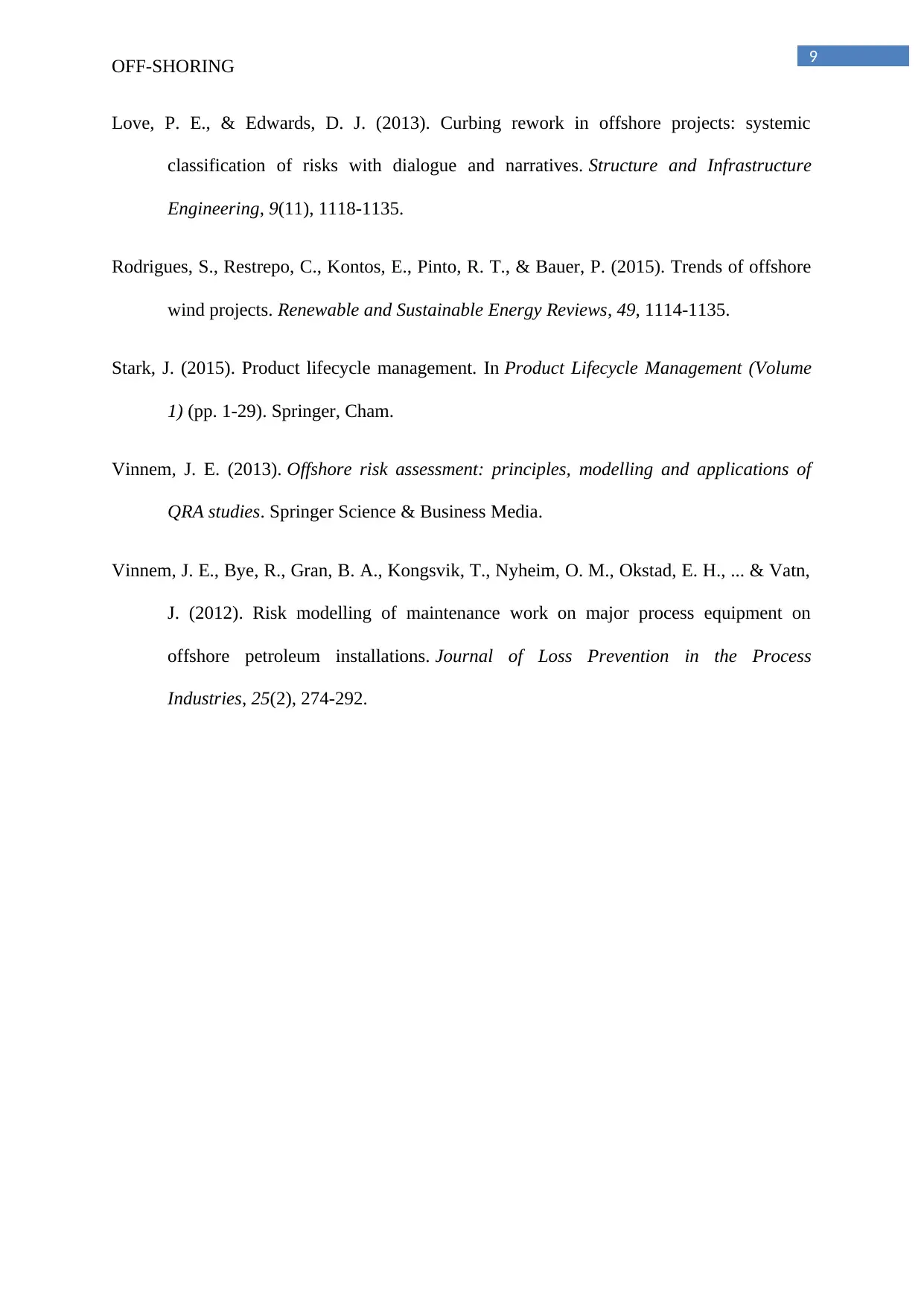
9
OFF-SHORING
Love, P. E., & Edwards, D. J. (2013). Curbing rework in offshore projects: systemic
classification of risks with dialogue and narratives. Structure and Infrastructure
Engineering, 9(11), 1118-1135.
Rodrigues, S., Restrepo, C., Kontos, E., Pinto, R. T., & Bauer, P. (2015). Trends of offshore
wind projects. Renewable and Sustainable Energy Reviews, 49, 1114-1135.
Stark, J. (2015). Product lifecycle management. In Product Lifecycle Management (Volume
1) (pp. 1-29). Springer, Cham.
Vinnem, J. E. (2013). Offshore risk assessment: principles, modelling and applications of
QRA studies. Springer Science & Business Media.
Vinnem, J. E., Bye, R., Gran, B. A., Kongsvik, T., Nyheim, O. M., Okstad, E. H., ... & Vatn,
J. (2012). Risk modelling of maintenance work on major process equipment on
offshore petroleum installations. Journal of Loss Prevention in the Process
Industries, 25(2), 274-292.
OFF-SHORING
Love, P. E., & Edwards, D. J. (2013). Curbing rework in offshore projects: systemic
classification of risks with dialogue and narratives. Structure and Infrastructure
Engineering, 9(11), 1118-1135.
Rodrigues, S., Restrepo, C., Kontos, E., Pinto, R. T., & Bauer, P. (2015). Trends of offshore
wind projects. Renewable and Sustainable Energy Reviews, 49, 1114-1135.
Stark, J. (2015). Product lifecycle management. In Product Lifecycle Management (Volume
1) (pp. 1-29). Springer, Cham.
Vinnem, J. E. (2013). Offshore risk assessment: principles, modelling and applications of
QRA studies. Springer Science & Business Media.
Vinnem, J. E., Bye, R., Gran, B. A., Kongsvik, T., Nyheim, O. M., Okstad, E. H., ... & Vatn,
J. (2012). Risk modelling of maintenance work on major process equipment on
offshore petroleum installations. Journal of Loss Prevention in the Process
Industries, 25(2), 274-292.
Paraphrase This Document
Need a fresh take? Get an instant paraphrase of this document with our AI Paraphraser

10
OFF-SHORING
OFF-SHORING
1 out of 11
Related Documents
Your All-in-One AI-Powered Toolkit for Academic Success.
+13062052269
info@desklib.com
Available 24*7 on WhatsApp / Email
![[object Object]](/_next/static/media/star-bottom.7253800d.svg)
Unlock your academic potential
Copyright © 2020–2025 A2Z Services. All Rights Reserved. Developed and managed by ZUCOL.



